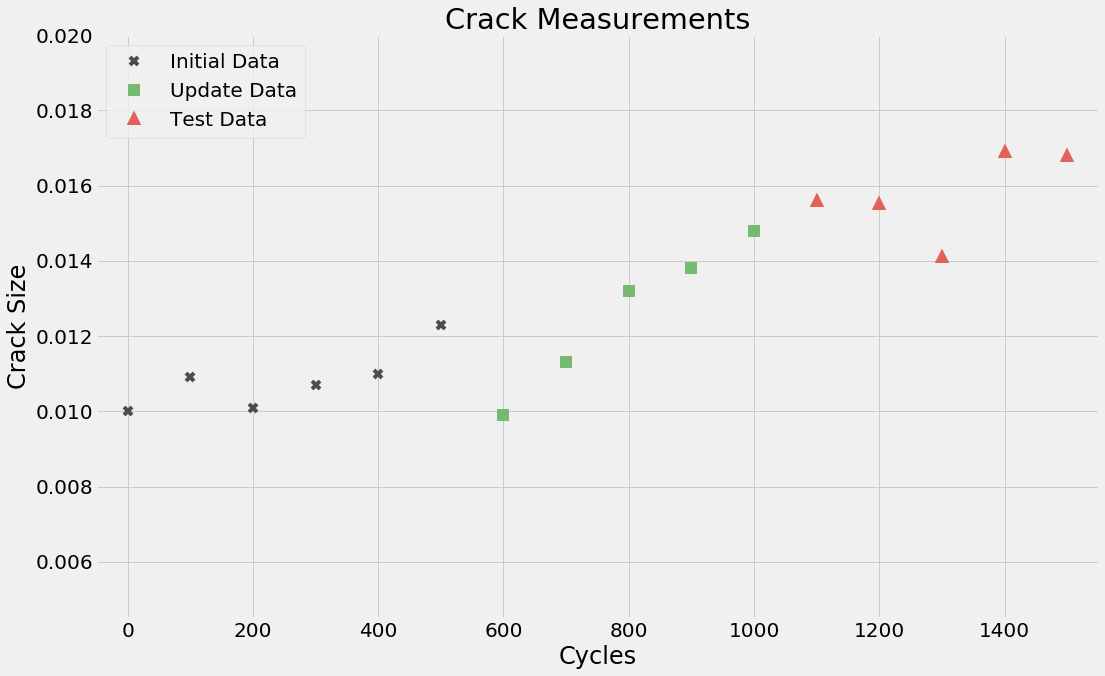2018 年 12 月 18 日 — 作者:Venkatesh Rajagopalan,数据科学与分析总监,以及 Arun Subramaniyan,BHGE Digital 数据科学与分析副总裁
在本系列的第一篇博文中,我们介绍了我们的分析理念,即结合领域知识、概率方法、传统机器学习 (ML) 和深度学习技术来解决工业界中最棘手的问题。我们还通过构建用于裂纹扩展的混合模型的例子说明了这种方法。我们与 TensorFlow Probability (TFP) 团队和 Google 的云 ML 团队持续合作,加速了我们大规模开发和部署这些技术的进程。以前难以解决的问题现在可以通过将物理知识与看似无关的技术结合起来,并利用现代、可扩展的软件和硬件来解决。

 与测量值相比,模型预测相当准确。初始数据集的均方误差 (MSE) 发现为:MSE(i)=3.93 10^-7。该模型对对应于更新数据集的时间段内的裂纹尺寸的预测如下所示。
与测量值相比,模型预测相当准确。初始数据集的均方误差 (MSE) 发现为:MSE(i)=3.93 10^-7。该模型对对应于更新数据集的时间段内的裂纹尺寸的预测如下所示。  很明显,初始模型的预测不再准确。更新数据点的 MSE 变为 MSE(u)=5.67 10^-6,几乎是初始误差 MSE(i) 的 14 倍!此外,随着循环次数的增加,模型预测和观察到的裂纹尺寸在更新数据集中存在明显的差异。因此,需要改进模型以提高其准确性。
很明显,初始模型的预测不再准确。更新数据点的 MSE 变为 MSE(u)=5.67 10^-6,几乎是初始误差 MSE(i) 的 14 倍!此外,随着循环次数的增加,模型预测和观察到的裂纹尺寸在更新数据集中存在明显的差异。因此,需要改进模型以提高其准确性。
## Inputs: State Vector - x_prev, Covariance Matrix - cov_prev, # States - num_st, UKF Parameter - kappa
## Output: Sigma Points Matrix - sig
[eigval, eigvec] = tf.linalg.eigh(cov_prev) # Eigen Decomposition of the covariance matrix
S_tf = tf.diag(tf.sqrt(eigval))
sqrt_cov = tf.matmul(tf.matmul(eigvec, S_tf), tf.matrix_inverse(eigvec)) # Square-root of the covariance matrix
eta = tf.sqrt((alpha ** 2) * (num_st + kappa)) # UKF scaling factor
sqrt_sc = tf.scalar_mul(eta, sqrt_cov) # Scaled square-root
sig = np.matlib.repmat(x_prev, 1, 2*num_st+1)
sig[:, 1:num_st+1] = sig[:, 1:num_st+1] + sqrt_sc
sig[:, num_st+1:2*num_st+1] = sig[:, num_st+1:2*num_st+1] - sqrt_sc # Sigma points## Inputs: Sigma Point Matrix - sig, UKF Weights - w0_mean, w0_cov, wi, # States - num_st, Process covariance - Q
## Outputs: Predicted State Vector - x_minus, Predicted Covariance - cov_minus
x_minus = w0_mean * sig[:, 0] + w_i * tf.reduce_sum(sig[:, 1:2 * num_st + 1], axis=1)
x_minus = tf.reshape(x_minus, (num_st, 1))
temp1 = tf.reshape(sig[:, 0], (num_st, 1))
# Predict Covariance
cov_minus = w0_cov * (temp1 - x_minus) * tf.transpose((temp1 - x_minus))
for i in range(1, 2 * num_st + 1):
temp1 = tf.reshape(sig[:, i], (num_st, 1))
cov_minus = cov_minus + w_i * (temp1 - x_minus) * tf.transpose((temp1 - x_minus))
cov_minus = cov_minus + Q## Inputs: Sigma Point Matrix - sig, Current Crack Size - init_crack, Stress Constant - dsig,
## Cycles Interval - diff_cycles, # States - num_st
## Output: Output Matrix - gam
gam = np.zeros((1, 2*num_st+1))
for indx in range(0, 2*num_st+1):
logC = sig[0, indx]
m = sig[1, indx]
gam[:, indx] = predict_crack(diff_cycles, logC, m, init_crack, dsig)## Inputs: Output Matrix - gam, Sigma Point Matrix - sig, State Vector - x_prev, UKF Parameters - w0_mean, w0_cov, wi,
## # States - num_st, Measurement Covariance - R
## Outputs: Cross Covariance - cov_xy, Output Covariance - cov_yy, Output Vector - yhat
yhat = w0_mean * gam[:, 0] + w_i * tf.reduce_sum(gam[:, 1:2 * num_st + 1]) # Output vector
temp2 = tf.reshape(sig[:, 0], (num_st, 1))
cov_yy = w0_cov * (gam[:, 0] - yhat) * tf.transpose(gam[:, 0] - yhat) # Output covariance
cov_xy = w0_cov * (temp2 - x_prev) * tf.transpose(gam[:, 0] - yhat) # Cross covariance
for i in range(1, 2*num_st+1):
temp2 = tf.reshape(sig[:, i], (num_st, 1))
cov_yy = cov_yy + w_i * (gam[:, i] - yhat) * tf.transpose(gam[:, i] - yhat)
cov_xy = cov_xy + w_i * (temp2 - x_prev) * tf.transpose(gam[:, i] - yhat)
cov_yy = (cov_yy + tf.transpose(cov_yy))/2 # Ensure symmetry
cov_yy = cov_yy + R## Inputs : Predicted State Vector - x_minus, Predicted State Covariance - cov_minus, Predicted Output - yhat,
# Measured Output - y, Output Covariance cov_yy, Cross Covariance - cov_xy
## Outputs: Updated State Vector - x_hat, Updated State Covariance - cov_hat
k_gain = cov_xy * np.linalg.inv(np.matrix(cov_yy)) # calculate filter gain
innov = y - y_hat # innovation
x_hat = x_minus + k_gain * innov # update state
cov_hat = cov_minus - k_gain * cov_yy * tf.transpose(k_gain) # update covariance
cov_hat = (cov_hat + tf.transpose(cov_hat)) / 2 # ensure symmetry 可以观察到,与初始模型相比,更新后的模型预测更准确。但这只是一个显而易见的结果,因为我们正在对用于更新模型的同一数据集进行预测。只有在使用未用于更新的数据集验证更新后的模型预测时,才能真正衡量更新后的模型的准确性。更重要的是,更新后的模型在预测裂纹的未来演变方面应该比初始模型更准确。否则,即使更新后的模型也并不特别有用。
可以观察到,与初始模型相比,更新后的模型预测更准确。但这只是一个显而易见的结果,因为我们正在对用于更新模型的同一数据集进行预测。只有在使用未用于更新的数据集验证更新后的模型预测时,才能真正衡量更新后的模型的准确性。更重要的是,更新后的模型在预测裂纹的未来演变方面应该比初始模型更准确。否则,即使更新后的模型也并不特别有用。 基于 UKF 的模型更新方法不仅估计模型参数的均值,还计算与估计相关的协方差。换句话说,它提供了状态变量的联合分布。TensorFlow Probability 的
基于 UKF 的模型更新方法不仅估计模型参数的均值,还计算与估计相关的协方差。换句话说,它提供了状态变量的联合分布。TensorFlow Probability 的 MultivariateNormalFullCovariance 函数用于创建样本,以计算与预测输出(在本例中为裂纹尺寸)相关的 uncertainty。预测裂纹尺寸的 95% 可信区间也绘制在上面的图形中。从图中可以清楚地看出,与初始模型相比,更新后的模型在预测裂纹的未来演变方面明显更准确。这表明 UKF 能够从更新数据集中的测量值中提取相关信息,以修改模型参数,使模型更准确、更有用。这里要提到的另一个重要事项是这种方法对噪声测量的鲁棒性。在更新数据集中,对应于循环 600 和 700 的测量值与其他测量的裂纹值相比是异常值。但是,这些异常值对模型更新过程的影响相当小,因为 UKF 没有尝试最小化这些数据点上的预测和观察之间的误差。这是一个理想的结果,这种对噪声测量的鲁棒性对于获得准确的更新模型至关重要。
最后,我们使用初始模型和更新后的模型预测裂纹尺寸到 2200 个循环。预测结果以及更新后的模型的 uncertainty 边界如下所示。
 从上面的图表中可以明显看出,如果使用初始模型,裂纹预测将非常不准确。实际上,初始模型将在 2100 个循环时产生错误警报,而此时发现大于修复阈值的裂纹的真实概率非常小(<< 5%)。
从上面的图表中可以明显看出,如果使用初始模型,裂纹预测将非常不准确。实际上,初始模型将在 2100 个循环时产生错误警报,而此时发现大于修复阈值的裂纹的真实概率非常小(<< 5%)。

2018 年 12 月 18 日 — 由 Venkatesh Rajagopalan(数据科学与分析总监)和 Arun Subramaniyan(BHGE Digital 数据科学与分析副总裁)发布
在本系列的 第一篇博客 中,我们介绍了我们的分析理念,即结合领域知识、概率方法、传统机器学习 (ML) 和深度学习技术来解决工业领域中一些最棘手的问题。我们还…